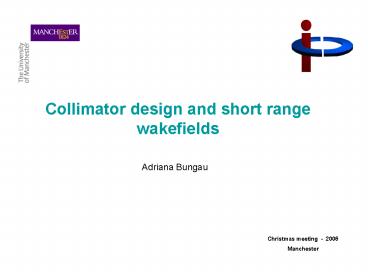Collimator design and short range wakefields - PowerPoint PPT Presentation
1 / 5
Title:
Collimator design and short range wakefields
Description:
Project: collaboration between Birmingham Univ, Manchester Univ, Daresbury Laboratory, ... EUROTeV reports and EPAC papers: ... EPAC paper: ... – PowerPoint PPT presentation
Number of Views:47
Avg rating:3.0/5.0
Title: Collimator design and short range wakefields
1
Collimator design and short range wakefields
- Adriana Bungau
Christmas meeting - 2006 Manchester
2
Collimator Design and Material Damage
- Aim design the optimal spoilers for the ILC (
geometry and material specification) - Project collaboration between Birmingham Univ,
Manchester Univ, Daresbury Laboratory, - SLAC and RAL
- Geant4 simulations in Manchester
- Collimator design - two types of spoilers a full
metal spoiler and a combinations of metal and
graphite - Three materials used Ti4Al6V, Copper, Aluminium
- Beam was sent through the collimator at 2 depths
2mm and 10 mm from the top - Decision of the best spoiler candidate was based
on - - instantaneous temperature rise
- - outgoing particle multiplicities
- - energy spectra of outgoing particles
- The best spoiler candidate was Ti alloy with
graphite - Results were cross-checked with Fluka and EGS4 -
passed on at RAL for ANSYS studies
EUROTeV reports and EPAC papers
- Geant4 Simulations of Energy Deposition in ILC
spoilers - A.Bungau, R.Barlow, N.Watson, EUROTeV
Report-2006-021 - Shower simulations, comparison of FLUKA,
GEANT4 and EGS4 - L.Fernandez, A.Bungau,
L.Keller, R.Barlow, N.Watson, EUROTeV-Report-2006-
034
3
Wakefield simulations with Merlin
- Current situation
- mathematical formalism for incorporating higher
order mode wakefields (R.Barlow) - formalism implemented in the Merlin code
- SLAC beam tests simulated (good agreement
between analytical calculations and - experiment
- so far, only simple beamlines were studied (ie.
Drift, Collimator, Drift)
EPAC paper
Simulation of High Order Short Range Wakefields
- R.Barlow, A. Bungau, EUROTeV-Report-2006-051
Studies are now extended to the ILC-BDS beamline
- emittance growth due to wakefields and
luminosity loss
4
Wakefield Measurements at SLAC-ESA
Motivation to optimize the collimator design by
studying various ways of minimising wakefield
effects while achieving the required performance
for halo removal
- Collaboration between SLAC, Birmingham,
Lancaster, Manchester, Daresbury - Commissioning Jan 2006 (4 old collimators) -
Successful - Physics first run Apr/May second run July
(8 new collimators CCLRC)
Experimental tests
- tested 8 collimators fabricated at RAL -
inserted collimators in beam path (x mover),
moved collimator vertically (y mover),measured
centroid kick to beam via BPMs - analysed
kick angle vs collimator position (good runs as
also bad runs)
EUROTeV reports and EPAC papers
- "Test Beam Studies at SLAC End Station A for the
International Linear Collider" -M.Woods et all,
EUROTeV-Report-2006-060, SLAC-PUB-11988 - "Direct Measurement of Geometric and Resistive
Wakefields in Tapered Collimators for the
International Linear Collider" - N.Watson et all,
EUROTeV-Report-2006-059, SLAC-PUB-12029
5
Plans for 2007
- Colimator damage
- beam tests for material damage (SLAC, CERN ?)
- Wakefield simulations
- studies for the ILC_BDS collimators with higher
order modes - implement Gdfidl predictions in Merlin
- Experimental tests at ESA
- next run March 2007 with 8 new collimators
- BPM reprocessing on the Manchester cluster
- data analysis finished for 2006 and also for
2007 - data comparison with the first 8 collimators
used in 2006 - Particle Accelerator Conference, June 2007-New
Mexico - 5 abstracts































